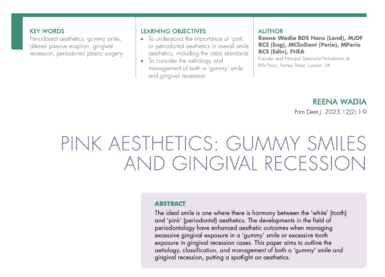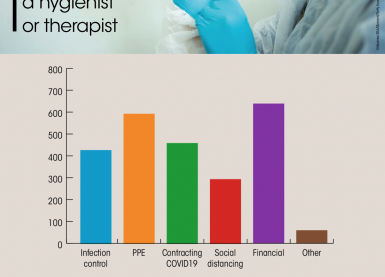
- Magnification is essential to perceive the detail required.
- A dry field is important for the optimal performance of your adhesive components. Rubber dam isolation is an absolute necessity. It is useful to isolate many teeth in the quadrant you are working on, as this will give something to compare against in terms of anatomy and occlusal plane when restoring. Ensure you check the occlusion prior to placing the rubber dam.
- It is important to analyse the materials you are using – use a few systems only and learn about their properties. This will improve predictability and outcomes.
- Composites may be VITA or non-VITA. VITA composites are codified according to the VITA shade guide. Non-VITA composites have one shade, more chroma for dentine and different values for enamel.
- In terms of shade, value is the most important characteristic that the human eye can perceive.
- Understand the properties of your composite and how they interact. For example, thickness will affect value.
- Know the refractive index of your composite: Natural enamel = 1.62; Composite enamel = 1.51.
- Light-cured composite for partial restorations cementation is preferable to dual-cured as it gives you more time to shape and adjust. The light-cured composite also has a better viscosity when heated.
- Always use a matrix for posterior composites – you should feel resistance as you place the your wedge in the interdental area. If you don’t you may not end up with a good contact area. There are many different types of matrices available.
- Dr Ferraris uses a 4th generation system for composites – etch (phosphoric acid 35-40%), primer and resin bonding to enamel and dentine.
- Appropriate adhesion is important but bear in mind that if the walls of the cavity are too fragile, this may lead to problems with microleakage, post-operative sensitivity and cuspal deflection.
- Heating composites to 39 degrees improves the viscosity and handling of the material.
- When restoring, use small balls of composite and place each of these in the cuspal area and remodel to achieve the correct morphology.
- There are many layering techniques– occlusalgingival, oblique and faciolingual. There is not much difference in the results of each of these but all are far more superior to the one-bulk technique.
- It might be a good idea to ask your patients if they would like their composite to have the staining feature. Even though you may be tempted to do this, some patients will not like it so check beforehand! However, if the clinician uses stains with minimal applications, it is not usually a problem for the patient.
- The performance of a carbide and diamond bur for finishing depends on the grit. The carbide bur is difficult to use as it needs to be used in a specific direction otherwise it can create irregularities.
- For anterior restorations, remember that shape is the most important feature. Following shape is: texture, value, opacity, chroma and hue respectively (Fondriest 2005).
- Posterior restorations should aim to achieve a marginal seal, provide pulpal protection as well as reproduce tooth morphology and maintain acceptable aesthetics.
- When reassessing patients with composites, rather than focusing on polishing, refine the shape and check the colour. The polish is less likely to be noticed due to the effects of saliva.
- Practice, reflect on your work and you will continually improve – “do better than yesterday”.
General Dental
Recent post
June 29, 2023
Pink Aesthetics...
Read more
General Dental,Periodontology
June 26, 2022
10 Key Points from EuroPerio10...
Read more
Periodontology,Reena's Notes
June 11, 2021
Working as a hygienist or therapist...
Read more
General Dental,Periodontology




